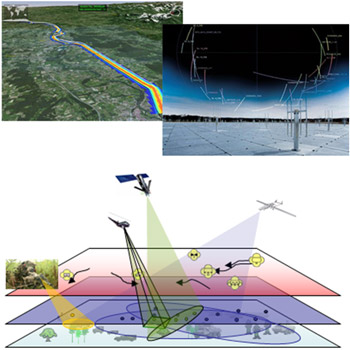- ONERA
- Scientific Departments
- DTIS - Information Processing and Systems
- Research units
DTIS - Research units
AEI | CASH | COVNI | CSAM EDO | ICNA | IDCO | IGNC | M2CI | MACI | MARS | MIC | MIDL | RFDS | RIME | S2AD | SAPIA | SEAS | SIMS
Automation, Experimentation, Integration (AEI)
The AEI research unit (Control, Experimentation, Integration) is tasked with analyzing and reinforcing the links between control theory and integration, to facilitate the transfer of the upstream work conducted at ONERA to our partners.
Based on a wide range of skills covering the main disciplines of automatics (system modeling, estimation, data fusion, control design, signal processing), the unit conducts research and develops tools to meet the specifications of aerospace and robotics stakeholders. The AEI research scientists design or adapt techniques to take into account integration constraints inherent in any experimental activity.
In this context, AEI is characterized by a strong experimental activity, using the numerous UAV platforms of the ReSSAC laboratory. Embedded avionics are designed from hardware to software. The exploitation of the experimental results enables the theoretical results to be matched against the field realities, and provides valuable feedback that ONERA can use for improving its methods and tools. The end goal of this approach is to make the studied systems more efficient, more secure and more robust / hazard-resilient.
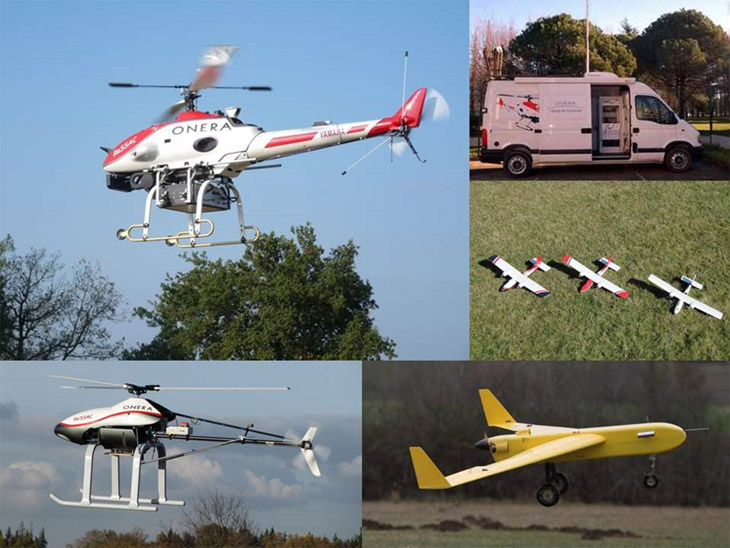
Control, verification and implementation (COVNI)
COVNI research activities are driven by the challenges raised by the ubiquitous digital aspects in modeling, analysis and optimization of dynamical systems, and by the implementation of advanced control/command algorithms on real systems. These activities are at the interface of Automatics, Computer Science and Applied Mathematics. Therefore, COVNI purpose consists in conducting scientific research which aims at developing both methods and tools able to:
- Firstly, address the growing complexity in modeling, analyzing, processing and controling dynamical systems (e.g., large-scale, hybrid, stochastic or parametric models, etc.)
- And, secondly, face the challenges represented by the implementation and validation of advanced control/command algorithms on execution platforms, in critical and demanding environments (code generation and validation, execution faults tolerance, etc.)
Thus, the intended goal lies in establishing a common and structured framework for the definition of a development chain that could be summarized as follows: "From complex systems to implementation: a safe and managed approach.". With time, COVNI research activities should make possible to:
(i) propose to industrial partners broader solutions
(ii) expand ONERA's portfolio within a structured framework
(iii) prepare ONERA for future scientific challenges by providing new answers to issues #1, #2 and #4 of its Strategic Scientific Plan
This group gathers today Control Theory research scientists interested in problematics associated to hardware constraints (e.g., implementation and numerical aspects) and Computer Science research scientists who tackle problems related to dynamical systems and to advanced control/command algorithms execution.
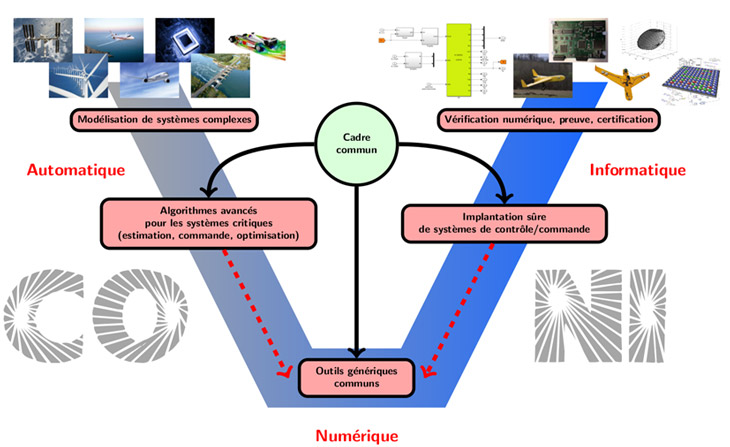
Cognitive engineering and applied neuroscience (ICNA)
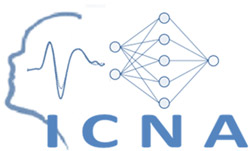 Cognitive engineering is a field combining cognitive science and engineering science around the problems relating to human/system interactions. Its goals range from the understanding of complex systems to their steering and coordination toward a general objective, which is often to improve the performance of systems composed of people and machines working in association.
Cognitive engineering is a field combining cognitive science and engineering science around the problems relating to human/system interactions. Its goals range from the understanding of complex systems to their steering and coordination toward a general objective, which is often to improve the performance of systems composed of people and machines working in association.
The ICNA (Cognitive engineering and applied neuroscience) unit conducts cognitive engineering activities for the development of new HSI (Human/System Interaction) concepts, with the goal of managing complex systems or operations e.g. many and interdependent variables, dynamic and strongly coupled processes, integration of humans in the steering or decision-making loop, etc.. These activities draw on an environment that is particularly rich in terms of information processing (in particular for the recognition and analysis of human activities), in terms of system control for managing dynamic human/system interactions, and in terms of interactive simulation (LABSIM resource).
Identification, flight dynamics and control (IDCO)
The field of activity of the IDCO (Identification, flight dynamics and control) unit is centered on the development of innovative methods and tools for designing control systems that meet ambitious performance and reliability objectives while complying with certification constraints.
Current developments aim at meeting the needs of future aerospace vehicle programs, by means of long-term collaborations with many industrial partners and agencies.
The skills of the unit's members cover all disciplines of automatic control that are useful to these activities: modeling for control and identification; identification of non-linear dynamic systems; state and parameters estimation; control design (robust, adaptive and non-linear control); analysis and validation of control laws; diagnostic and reconfiguration for flight safety.
The unit also has multidisciplinary skills in particular, a solid know-how of flight dynamics, regularly solicited for expert assessment of handling qualities and flight control systems in new aircraft concept projects.
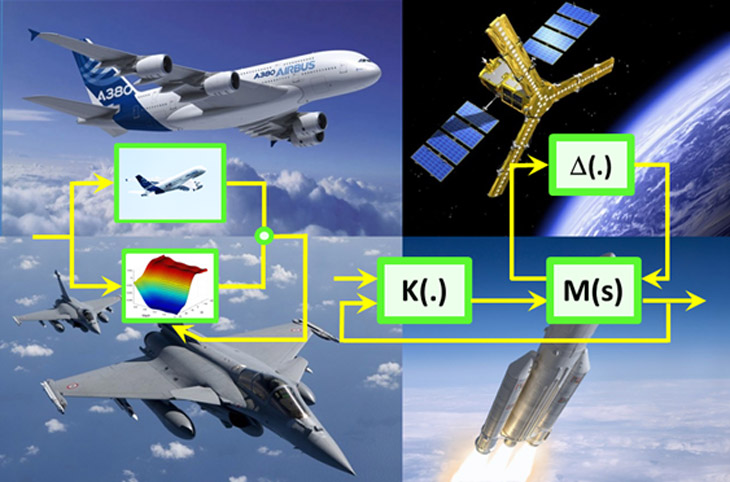

Development of guidance-control laws of the EOLE demonstrator, validation on simulator and flight tests

Aeroelastic model identification for flutter flight tests
Multidisciplinary methods, integrated concepts (M2CI)
M2CI (Multidisciplinary methods, integrated concepts) takes advantage of the applications-methods duality in the field of aerospace vehicle design for:
- On the one hand, developing methods inspired by the needs of applications and validated on representative cases of these needs
- On the other hand, proposing and assessing innovative integrated concepts for aircraft or launch vehicles, the definition of which is improved by the use of appropriate design methods
The developed methods (optimization algorithms, MDO formulations, surrogate models, uncertainties management) aim at increasing the number of disciplines covered, improving multi-fidelity exploration of the design space, and quantifying uncertainties in a multidisciplinary framework. From the application viewpoint, the goal is to promote innovative concept ideas (e.g., hybrid-electric aircraft, reusable winged launch vehicles), from initial exploration to expert assessment for the benefit of the sector's manufacturers, including collaborative approaches at national or European level.
Lastly, the team promotes:
(i) capitalization of the models and methods in the form of building blocks integrated within a shared design environment at ONERA
(ii) validation of certain concepts or technologies through the specification and deployment of demonstrators.
It seeks to develop national or international cooperation with other laboratories or research centers on the methodological aspects, and a partnership approach with industry for the development of innovative concepts. It works in natural synergy with the other units of the DTIS (Information processing and systems) on the Design and Optimization topic, and with the ONERA specialized departments for disciplinary issues.

Applied mathematics and scientific calculation (MACI)
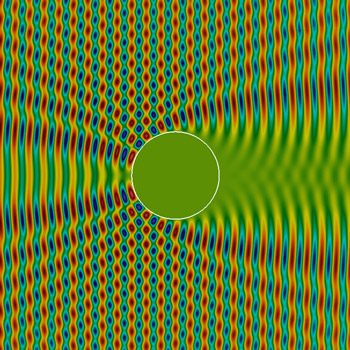
Visualization using the Previsio software
of a compressed and precise representation
of acoustic radiation by a diffracting
sound-soft object
MACI (Applied mathematics and high performance computing) supports the development activities for ONERA's codes. The work carried out is aimed mainly at the development of ONERA's major software, and is conducted jointly with the teams of the other departments.
The team's skills cover a wide range of applied mathematics. They work on high-order schemes, multi-scale modeling, integral formulations, domain decomposition methods and optimization algorithms. The resolution of linear systems and their implementation on parallel and multi-core architectures is also a skills area of the unit.
This work leads to the development of modules in ONERA's software or in external software components.
Development and validation are performed on different types of computer architectures.
Modeling and engineering of distributed systems and software (MIDL)
The MIDL (Modeling and engineering of distributed systems and software) unit deals with IT applications in the broad sense, and aims at promoting and facilitating the implementation of IT methods in actual application frameworks. Firstly, as part of its research activities, the unit develops IT methods in a process ranging from the analysis of needs up to the implementation of integration frameworks by way of three scientific approaches: software engineering, distributed systems, and reasoning models. Secondly, its members as a whole are highly knowledgeable in different application domains and are open to new applications. The unit is twin-site, with each component of the unit able to serve as a local relay for those on the other site, thereby supporting the cross-functional momentum of the department and breaking down silos between methods by way of the various application domains linked to the local ecosystems.

Rotorcraft, Flight Dynamics and Systems (RFDS)
RFDS works on the modeling and simulation of the flight dynamics of rotary-wing aircrafts : helicopters, tiltrotors, combined fixed/rotary-wing, tandem, coaxial or innovative architectures, distributed propulsion, hybrid, electric... Its main goal is to help the design and assessment (performance, handling qualities and environmental impacts) of future aircraft: piloted, OPV or UAV. Beyond these skills, the unit has extensive know-how of the operational and regulatory contexts, which it uses for benefit of developing crew aid systems for new avionics (advanced control laws, mission management aid, flight envelope protection aid, etc.).
In this way, all its work contributes to efforts for improving flight safety in conjunction with operational performance. The unit also has a system prototyping bench (PycsHel simulator), integrated within the LABSIM laboratory, enabling it to assess the aircraft and systems that it develops. Its experise goes up to piloting simulation and flight testing, for which it is supported by its operational partners (DGA-EV, CEPA, etc.).
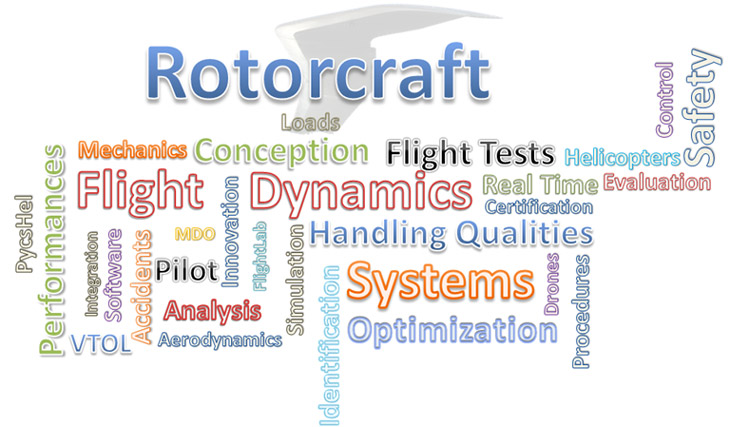
Risk – Identification, modeling and assessment (RIME)
The RIME (Risk – Identification, modeling and assessment) unit focuses on the development and implementation of methods and tools for:
- identifying the regulations and requirements applicable to systems
- modeling the architectures and concepts of use of these systems
- assessing as early as possible the inherent risks
- analyzing the gathered data throughout the service life of systems
These activities also relate to the system definition from a technical point of view, as well as a human and organizational perspective. The risks under consideration are linked to the safety of property, people and information. They may also be linked to other aspects, such as compliance with environmental constraints, integration of ethical considerations or satisfaction of performance indicators. The methods and tools developed by the unit are based on approaches issuing from various scientific areas (artificial intelligence and decision-making, engineering of systems and software, applied mathematics, scientific calculation).
In the coming years, particular emphasis will be placed on the application of the techniques developed by RIME to the current and future air transport system, and to UAV systems. This work will be carried out in close links with the other units of DTIS working on these topics.
Surveillance Systems for Aerospace and Defense (S2AD)
S2AD (Surveillance Systems for Aerospace and Defense) is application and system oriented towards the following domains:
- space surveillance and all associated missions, with activities covering the technical-operational side and upstream studies
- airspace surveillance and, in particular, expertise developed around the Air Command and Control System and C2's in general
- surveillance and space systems, especially related to the assessment of their vulnerabilities to threats either intentional or not
- early warning, in particular via the architecture assessment or the development of innovative proliferation surveillance concepts
- airborne surveillance systems, including in particular drones for surveillance or inspection missions, associated with the multi-vehicle GNC aspects, multi-sensor merging and optimization of dynamic sensor networks
The unit studies, adapts or develops dedicated methodologies in all the scientific fields, with a focus on estimation, control, information processing, modeling, and performance assessment.
Safe Embedded and Autonomous Systems (SEAS)
The mission of SEAS (Autonomous and secure onboard systems) involves the development and secure operation of onboard systems and autonomous systems. To this end, it particularly focuses on issues of specification, design and analysis, dealing with their formal aspects.
To address these various issues researches are based on:
- formal specification languages
- languages for modeling system architectures or their behavior
- formal verification or real-time analysis techniques
- architectures and algorithms for decision-making, from task planning to execution management
- decision-making and multi-machine mission management architectures, distributed between ground stations and onboard systems
- tools and methods for installation on physical platforms
The work of the SEAS unit also includes an experimental component, with implementation on various platforms (drones, robotics, cyber-physical systems, aeronautical systems).

